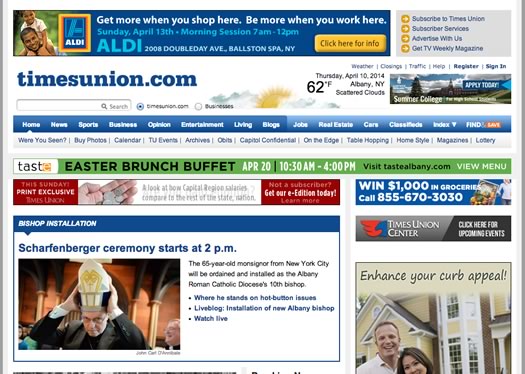A few bits about the shifting place of the Catholic church in the Capital Region

The Cathedral of the Immaculate Conception, viewed from the Corning Tower.
On Thursday the Albany Roman Catholic Diocese is got a new bishop -- Edward Scharfenberger -- and it's being treated as a Big Story by the local media. Example: The Times Union was running a special "Bishop Installation" box above all the other news items on the front page of its website.
Why so much attention? Well, probably because the Catholic church has been a prominent part of the fabric of this area over the last century, and a lot of people here are Catholic. The Albany area, like many parts of the Northeast, was the destination for many immigrants from traditionally Catholic countries in Europe such as Ireland and Italy. And you can still see the effects today: There are Catholic church buildings all around cities in the area, and the Cathedral of the Immaculate Conception is a part of the Albany skyline.
But the last decade has also seen significant change in the Catholic church's local presence. The 14-county diocese recently went through a multi-year process to consolidate and close 33 worship sites (about 20 percent of its total). In Troy alone, six churches were closed.
So we were curious about the local Catholic population now fits into the whole picture for this area. A few facts and bits...

Big story placement.
Catholic population
There are 337,200 Catholics in the 14-county Albany Diocese (map), according to the Vatican. With an estimated population of 1,374,000 for that region, Catholics make up 24.5 percent of the population.
Catholic population over time
At nearly a quarter of the population in the region, Catholics are a significant segment. But their share of the whole has been declining for decades.
Since 1950, the Albany Diocese's population of Catholics peaked at 426,968 in 1968, according to figures tracked by the website Catholic Hierarchy. As a share of the total regional population, the peak came in 1959 at 34.7 percent.
Number of priests
Another bit from Catholic Hierarchy: In 1965, there were 473 priests serving 208 parishes in the diocese. In 2012, there were 189 priests serving 128 parishes.
In its parish consolidation plan, the Albany Roman Catholic Diocese projects there could be fewer than a hundred priests in the diocese sometime during this decade.
Schools
One of the reasons Catholic churches played such prominent role in their communities was their schools. But nationwide the number of students attending Catholic schools has been declining since at the 1960s, with large declines over the past decade. [National Catholic Education Association]
A local example: The last decade has been particularly tough on Catholic schools in the city of Albany -- enrollment dropped 65 percent between 1998 and 2012. [TU 2012]
The future?
A Pew Research Religion and Public Life Project report from 2013 noted that Catholics' share of the overall national population has more or less remained steady at about 25 percent for decades. But that's not to say that little has changed:
The Catholic population in the U.S. has undergone some striking demographic shifts despite hovering around a quarter of the population for several decades. For example, the Catholic population has lost more members than it has gained from religious switching. In fact, one-in-ten adults in the United States is a former Catholic, according to the Pew Research Center's 2009 report "Faith in Flux."
In addition, the Catholic population in the U.S. has been heavily shaped by immigration and includes a rising share of Latinos. More than half (52%) of all migrants to the United States are Catholic. Of the estimated 75.4 million Catholics in the United States in 2010, 22.2 million were born outside the United States (30%). By comparison, slightly more than 13% of the overall U.S. population is foreign-born.
Just about 4 percent of the Albany metro area's population is Latino, according to the Census Bureau, compared to about 16 percent of the United States. But the number of Latino people here is on the upswing, up more than 90 over the last decade. [TU]
If that trend continues, it could also mean a shift for the Catholic church here as well.
Hi there. Comments have been closed for this item. Still have something to say? Contact us.
Comments
My wife and I are both recovering Catholics and proud of it.
... said Harold on Apr 10, 2014 at 7:27 PM | link
This was really an interesting read. Thanks.
... said Alisa on Apr 11, 2014 at 9:37 AM | link
I wonder how the rate/pattern of abandonment of regular affiliation with churches/organized religion - I suppose in this case specifically in a Catholic context - compares among Latino and other demographic(s) versus Caucasian or other in America, and/or specifically this region.
The article cited states that "of the ... 75.4 million Catholics in the US ... [30% were born outside the US]." What's the rate of non-identification among their children, in other words?
... said Alex on Apr 11, 2014 at 12:38 PM | link
In other news, the Church of The Flying Spaghetti Monster is growing at twice the pace of any other religion. Pastafarians just recently acquired the right to publicly wear colanders as headgear without the risk of being arrested for decent exposure. Also noteworthy is their adoption of their new pasta menus for the entire week, which is entirely vegetarian...ughhh! Why do I feel that these religion-based scams are coming to an end?
... said Joe A on Apr 11, 2014 at 1:31 PM | link
The Catholic church is facing decline. I have recently converted to the church of Jesus Christ of latter day saints. The old Catholic traditions are not true to the scriptures. All in all build your relationship with God. I'm a Mormon and proud of it!
... said Matt A on May 5, 2014 at 3:06 PM | link